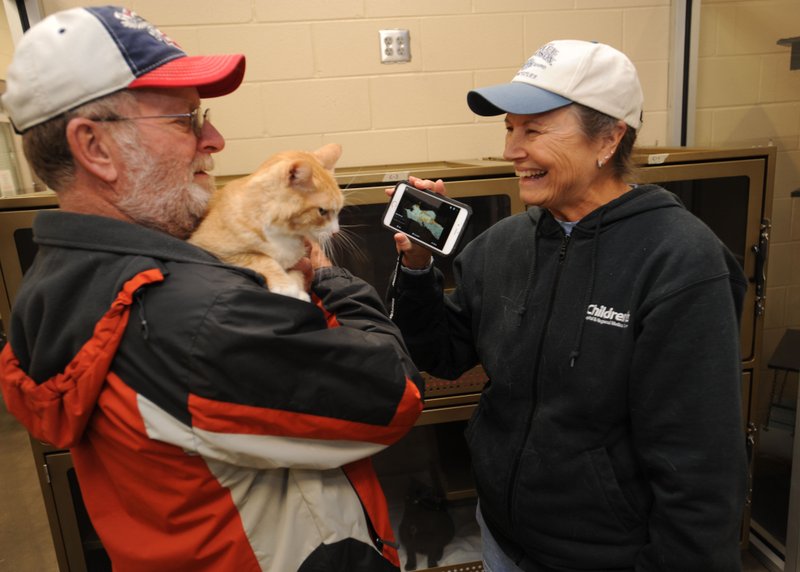Multiple animal shelters in Northwest Arkansas have reduced their euthanasia rates over the past few years.
Courtney Kremer said she started working as director of Springdale Animal Services in August 2012. The euthanasia rate at the shelter was 51 percent in 2011. That decreased to 21 percent in 2014, according to data from Spay Arkansas.
By The Numbers
Animal shelters in the U.S.
• 31 percent: Dogs euthanized after entering shelters.
• 41 percent: Cats euthanized after entering shelters.
• 3.9 million: Dogs that go into animal shelters every year.
• 3.4 million: Cats that go into animal shelters every year.
• 1.4 million: Dogs adopted from animal shelters each year.
• 1.3 million: Cats adopted from animal shelters each year.
• 13,600: Animal shelters in the U.S.
Note: Numbers are approximate.
Source: aspca.org
Spay Arkansas is a nonprofit organization in Springdale offering spay and neuter services, according to the organization's website. Shelters aren't required to report euthanasia numbers, but many report numbers voluntarily to Spay Arkansas.
Kremer explained Springdale reports deaths of all dogs and cats coming into the shelter unless they are dead on arrival. Animals can be euthanized for various reasons, including the euthanasia being court ordered, an animal not adapting to the shelter or lack of space.
Kremer said the reduction in euthanasia rates at Springdale's shelter has been a team effort. She credited the Springdale staff, volunteers, foster homes and community for the decrease.
"We really did good things last year," she said.
Among the factors in reducing euthanasia is Springdale's City Council has increased the budget for veterinary care and more people are fostering animals, Kremer said. There were three volunteers and no foster homes when she started working there, and now there are more than 30 volunteers and at least 12 foster homes.
A new puppy room and new cat rooms at the shelter could also be factors, Kremer said. The puppy room helps with disease prevention, while the cat rooms can help the cats feel less stressed and, in turn, less susceptible to sickness.
There will always be some animals euthanized, Kremer said. However, she said she wants to see the rates decrease further. She mentioned she thinks euthanasia for space reasons is unacceptable.
Kremer said she would like for the Springdale shelter to increase its use of rescue organizations allowing cats and dogs to be moved out of state for adoption.
Fayetteville Animal Shelter greatly reduced its euthanasia rate for cats and dogs from 2011 to 2014, according to data from Spay Arkansas. The shelter's euthanasia rate was 36 percent in 2011 and 10 percent in 2014.
Fayetteville includes any cat or dog euthanized after intake in numbers it reports to Spay Arkansas, said Justine Lentz, animal services superintendent. This doesn't include any animal that dies naturally after intake instead of by euthanasia. However, that's rare, she said.
The biggest catalyst for the Fayetteville shelter's reduction was opening Washington County Animal Shelter in September 2012, Lentz said.
Fayetteville had a 36 percent euthanasia rate in 2011, and included cats and dogs from Washington County, according to data from Spay Arkansas. That rate declined to 23 percent in 2012.
Other factors, including mandatory microchipping of pets in Fayetteville and promotion of spaying and neutering of cats and dogs, contributed to the decline, Lentz said. Scannable microchips implanted in an animal's neck can provide information about how to contact owners.
The Fayetteville shelter's euthanasia rate was 9.4 percent for Jan. 1 to Oct. 31, Lentz said.
Washington County Animal Shelter reduced its euthanasia rate from 2012 to 2014, according to data from Spay Arkansas. The shelter's euthanasia rate was 23 percent in 2012 and 18 percent in 2014.
The shelter's euthanasia rate includes all adoptable animals euthanized to make space, said Angela Leatherwood, director of the shelter, in an email. She described adoptable animals as those that aren't "contagiously sick, suffering or behaviorally dangerous." The shelter hadn't euthanized any animals to free space in 2015 as of Friday.
Ledgerwood wrote the shelter has taken multiple steps to reduce its euthanasia rate. Among those steps are an advertising campaign, use of social media and organizing adoption specials.
"By increasing adoptions we automatically decrease euthanasia," she wrote.
Ledgerwood also mentioned the shelter "must work harder to find additional reputable rescue groups to take the animals." She also wrote about the need to "increase the number of people entering the shelter" to adopt pets.
Bella Vista Animal Shelter reduced its already-low euthanasia rate from 2011 to 2014, according to data from Spay Arkansas. The shelter's euthanasia rate was 5 percent in 2011 and 4 percent in 2014.
The nonprofit shelter includes all deaths in its rate, said Tammie Cavness, assistant shelter manager. This excludes an animal that arrives dead, said Deidre Knight-Matney, executive director.
Cavness said the shelter keeps its euthanasia rate low by using rescue organizations in different states and encouraging adoption through participation in events.
"We don't want to euthanize anything unless we absolutely have to," she said.
The Bella Vista shelter had a 3.6 percent euthanasia rate from Jan. 1 to Oct. 31, Knight-Matney said.
Rogers Animal Shelter greatly reduced its euthanasia rate from 2011 to 2014, according to data from Spay Arkansas. The shelter's euthanasia rate was 26 percent in 2011 and 8 percent in 2014.
Rogers includes any cat or dog euthanized after intake, said Bud Norman, director of Rogers Animal Services. It doesn't include natural deaths.
Norman described the factors for reducing euthanasia as many pieces of a puzzle. Some of those pieces are building the shelter's customer base and the shelter's work with rescue organizations. The shelter sends an average of about 100 animals a year to out of state rescue organizations. Most are dogs.
Shelters could decrease their euthanasia numbers even further by increasing awareness of looking for lost pets at shelters and increasing awareness of adoption, Norman said. The Rogers shelter had a 1.5 euthanasia rate for 2015 as of Thursday.
NW News on 11/22/2015



